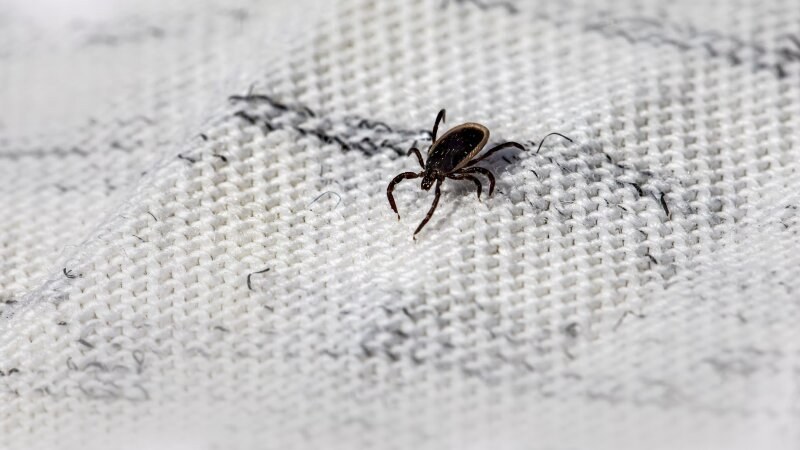Flea and Tick Season: Protecting Your Pets and Home
Reading time: 6 minutesThe arrival of spring in Western Canada also marks the start of flea and tick season. No one likes these creepy – and dangerous – crawlies, and if you have pets at home, this can make things even more of a hassle.
Fortunately, there are many things you can do to help reduce the presence of fleas and ticks around your home. Here’s what to know and how Buzz Boss can help.

The Importance of Flea & Tick Control
Taking proactive steps to control fleas and ticks is imperative for keeping your pets and family safe. Ticks carry harmful pathogens and potentially even deadly illnesses like Lyme disease, tularemia, anaplasmosis, and Rocky Mountain Spotted Fever, so you don’t want them anywhere near your home.
Fleas usually don’t harbour dangerous diseases but can proliferate in your house and cause an infestation. These insects cause itchy bites like mosquitoes and can spread tapeworms between your pets.
Some animals can be very allergic to flea bites and have serious reactions that require medication to treat. Eliminating fleas is difficult and can take a long time, so prevention strategies are especially important.
How to Control Ticks & Fleas in Your Yard
Backyard tick control is essential in the spring and summer when these unwanted insects can easily hitch a ride on the back of your pet and enter your home.
How to Get Rid of Fleas & Ticks In Your House
If you happen to get fleas in your house, you’ll need to take several steps to eradicate them:
- Use flea prevention on your pets. First, you’ll want to stop fleas from being able to bite your pet and transmit disease. This can be done with spot treatment, flea collars, flea shampoo, and other remedies used on your pet’s skin or coat. Plus, most pet flea treatments also work to repel ticks.
- Treat your front and backyards. Next, you’ll want to create a barrier between the pests and your home. Treating your front and backyards, plus any trees along your property line, can help establish a “no-fly zone” for fleas, ticks, and other unwanted insects. This can be done with our BuzzShield Insect service, natural products or special insecticides.
- Remove bedding, clothes, and towels. Fleas tend to hide and lay eggs in clothes, bedding, towels, and rugs. These items are likely infested, even if you can’t see anything, and need to be removed from your home and washed, treated, or thrown away. Pay special attention to pet bedding and consider just replacing it completely.
- Treat your home. There are many ways to treat your home for fleas, ranging from over-the-counter sprays and powders to professional extermination services. When dealing with hard-to-fight infestations like fleas, you’ll get the best results by calling the experts.
- Follow up with prevention services. Once your pest problem is under control, prevention becomes even more important. The last thing you want to deal with is the hassle and expense of getting rid of fleas all over again.

Tips to Keep Ticks & Fleas Away for Good
There are also several things you can do to maintain your home and yard to keep fleas and ticks at a minimum. The Government of Canada recommends that pet owners:
- Vacuum daily. Fleas can lay almost 50 eggs every day for a month, according to The Canadian Encyclopedia. That’s 1500 fleas! And if each of those fleas reaches adulthood and lays 50 eggs every day for a month, that adds up to 75,000 fleas. If the infestation goes on even just one month longer, you’re looking at nearly 4 million.
- Wash pet bedding often. You should wash pet blankets, beds, and soft toys in hot, soapy water every couple of weeks. If the infestation is bad, we recommend every week or more.
- Clean around baseboards. It’s a common misconception that fleas only get into carpets and upholstered furniture. They can also nest and lay eggs in the cracks between your baseboards and walls. Steam cleaners get incredibly hot and do far more to sanitize than a mop or wiping can. The extreme heat that steam cleaners produce is highly effective at killing both adult fleas and eggs on contact.
- Keep cats indoors. Unlike most dogs, cats that are allowed outdoors can sneak into bushes or climb into trees where there are significantly more ticks.
- Mow and rake frequently. Fleas and ticks nest outdoors in dark, well-covered spaces like tall grass and leaf piles. One of the most important parts of pest control for the inside of your home is making sure there are fewer unwanted insects outside of it, so be sure to rake and mow often to keep hiding spaces to a minimum.
- Repair window screens with holes. It’s tempting to throw the windows open when the weather is nice. But if your screens have holes, gaps around the sealing, or other openings that insects can enter, this could create bigger problems. Check and repair window screens every spring and fall to ensure nothing can get in. This also helps to keep out other annoying or harmful pests like mosquitoes.
- Inspect pets regularly. It’s a good idea to get into the habit of inspecting your animals frequently for the presence of ticks, fleas, or flea eggs. Since ticks need to be attached for at least 24 hours to transmit Lyme disease, according to Infection Prevention and Control Canada (IPAC), regular inspections can help you catch and remove them before this happens.
Frequently Asked Questions (FAQs) About Flea & Tick Control
Is natural pest control effective?
Protecting nearby wildlife and their habitats is critical when getting rid of fleas and ticks. Environmentally friendly pest control strategies can help protect non-target species and prevent contamination of groundwater supplies, but they can sometimes be less effective than other treatments.
At Buzz Boss, we use Integrated Pest Management (IPM) techniques to minimize the use of potentially harmful compounds and employ them only when necessary.
Do I need to use a spot treatment on my pet?
While spot treatment isn’t the only form of flea and tick prevention available for pets, it’s considered the “gold standard” by veterinarians for a reason.
Be sure to purchase from your vet or a pet supply store and avoid shopping over-the-counter at superstores or farm supply stores. Off-brand flea and tick treatments are often unregulated and have improper dosing instructions, possibly poisoning your pet.
What plant do ticks hate?
Like most pests, ticks hate certain plants and flowers. Geraniums, in particular, are said to repel ticks and can be especially effective at keeping them at bay when planted as a border around your yard. Sage, catnip, and mint varieties may also be helpful.

Buzz Boss—Your Residential Pest Control Partner
Flea and tick season is here, and Buzz Boss is ready. Are you?
Our expert pest defence and local tick control specialists can help you get rid of infestations quickly and prevent them from coming back so you and your pets can enjoy your space all year long.
We serve Western Canada, including Calgary, Edmonton, Red Deer, Regina, Saskatoon, Winnipeg, and Okanagan.
Book preventive tick control to keep your yard safe through the summer.

